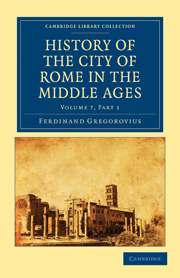CHAPTER IV
Published online by Cambridge University Press: 01 March 2011
Summary
The death of Sixtus IV. was the signal for the insurrection of the adverse party, which had been so long suppressed. Rome was filled with wildest tumult. Hell seemed to be let loose. Friends and enemies, barons, citizens and cardinals barricaded their houses, while the people, in their indignation at the grasping rule of Sixtus's nephews, sacked the palace of Riario near S. Apollinare and plundered the granaries and the banks of the Genoese moneychangers. On August 14, however, on the news of the Pope's death, Girolamo and Virginius hurried by forced marches to Rome, leaving in their hasty flight their camp at Palliano to the enemy. The cardinals ordered them to remain at Torre del Quinto; but Catarina, Girolamo's brave wife, threw herself into S. Angelo, to hold it for her husband. With like haste came the Colonna thirsting for revenge, first the Cardinal, whom the people conducted with rejoicing to his palace near Trevi, then Prospero and Fabrizio, the Savelli and other Ghibellines. The nephew Girolamo despaired of retaining further influence over the Papacy and Rome; he withdrew to the Orsini at Isola. Barricades were erected throughout the entire city. Squadrons of cavalry from Monte Giordano rode through the streets with the cry, “Orsini and the Church”; their opponents from the SS. Apostoli rushed through the Campo Marzo with shouts of “Colonna!” Civil war seemed imminent.
- Type
- Chapter
- Information
- History of the City of Rome in the Middle Ages , pp. 287 - 404Publisher: Cambridge University PressPrint publication year: 2010First published in: 1900

